During the wartime years Mellieħa, which was far away from the main military installations of Malta of that time, didn't get the attention of the enemy. However, sometimes bombs were dropped in different parts of the village, especially on Għadira Camp and Fort Campbell. Due to this feeling of safety there were hundreds of Maltese refugees who sought refuge in the village. They came from the Harbour area and the nearby villages of the aerodrome. As we shall see during the April Blitz, Mellieħa was to experience its biggest raids in one day. The main sources for re-accounting the April Blitz and Mellieħa and used in this series of articles are the Malta Police Reports and the Diary of the 1st Battalion King's Own Malta Regiment (KOMR), which at that time were stationed at Mellieħa to defend the village in case of an enemy invasion.
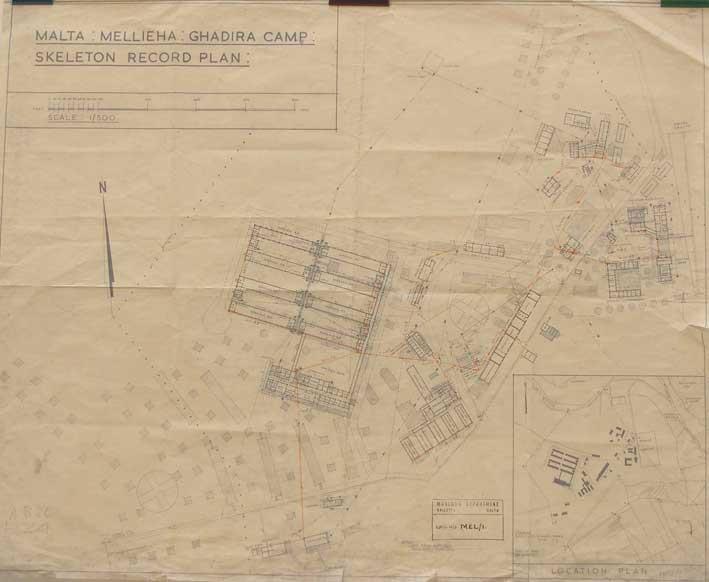
Plan of Mellieħa Bay Camp (Source: National Archives)
First attacks on Mellieħa of the month
According to the Police Reports, the first Air Raid Warning (Air Raid No. 1954) of the April Blitz in Mellieħa was sounded at 9.13am of 1 April 1942, when two Messerschmitt Bf109Fs strafed Marfa Palace Hotel and L-Aħrax Tower, but didn't cause any casualties or damages. The Raiders Passed was sounded at 10.34am. According to the Diary of the KOMR, at 10.30am four Me109s machine-gunned Beach-Posts MA3 and MA6 at Armier Bay and L-Aħrax Tower. This attack came to an end at about 12.18pm. Just around three hours later, at about 3.35pm, two ME109s attacked Għadira Camp, but no casualties or damage were reported.
In the early morning of 4 April at about 7.10am two ME109s machine-gunned Għadira Camp and Marfa East Ridge, but again there were no casualties or damages. Two days later (6 April), at about 2pm, the Għadira Camp was again machine-gunned but no casualties or damages were reported. On 8 April, four ME109s appeared over Mellieħa Bay at 2.05pm and attacked Għadira Camp. The Recruits Training Depot fired on the enemy fighters probably with Bren Guns on tripods. Two hours later, at 4.15pm a stick of four 500kg bombs were dropped and exploded south of Selmun Palace, where the blast slightly damaged the same building, but there were no casualties. On 10 April at 1.13pm Axis fighters machine-gunned Ta' Ciantar Tower at Għajn Żnuber, but there were no casualties or damages. During the evening of the next day (11 April), at 6pm four ME109s appeared over Mellieħa, and they attacked Għadira Camp and Selmun Palace. Light Anti-Aircraft Gun/s, probably 40mm Bofors LAA guns and small arms such as Bren Guns mounted on tripods, fired against the enemy fighters. The attacks slightly damaged the buildings, but there were no casualties.
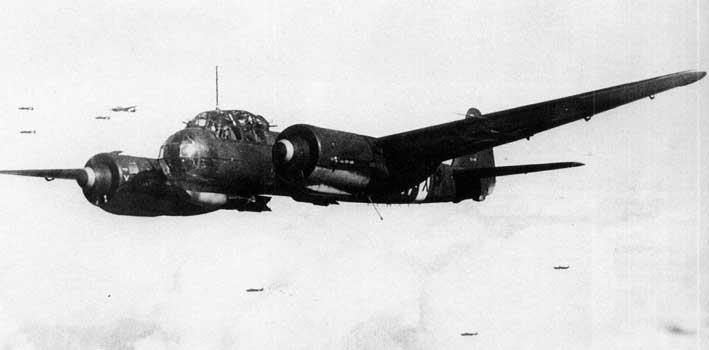
A Junkers Ju88A-6 of KG54 flying over Italy in early 1942.
According to the Police Reports, in the early morning, on 14 April, an Air Raid Warning (Air Raid No. 2089) was sounded at 6.30am. It remained in force until 7.56pm, when finally the Raiders Passed was sounded. At one time or another five bombs were dropped and exploded on the rocks at Mellieħa Bay, which fortunately didn't cause any casualties or damages. However, according to the Diary of the 1st Btn, at 6.38pm, Axis bombers dropped bombs on Għadira Camp, but there were neither damage nor casualties. Four-and-a-half hours later (10.50pm) enemy aircraft dropped bombs between Selmun Palace and the remains of Għajn Ħadid Tower. One bomb didn't explode. So neither sources agree with the time of raids and places attacked.
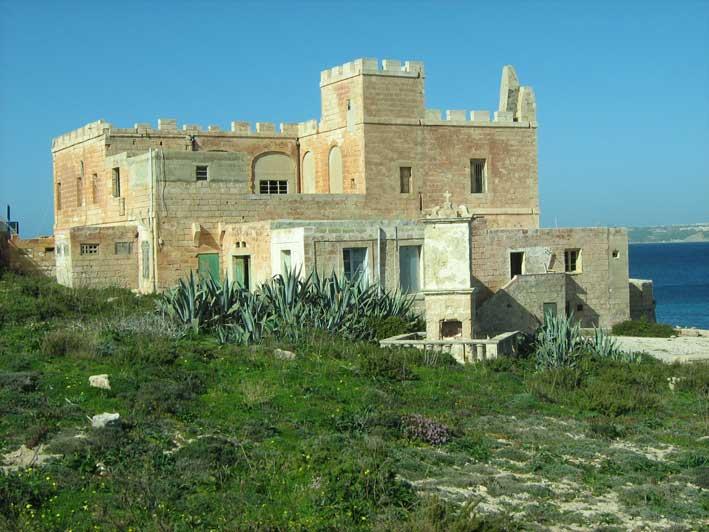
The former Marfa Palace Hotel which was formerly known as Wied Musa coastal battery built by the Hospitallers between 1715-16.
If we were to rely on the Police Reports, it is evident that apart from the proper air raids there were also nuisance raids in order to keep the Anti-Aircraft gunners and the RAF pilots on continuous alert and the civilian population remaining in refuge in their shelters. This type of aerial tactic was done to bring the morale of the garrison and civilians at the lowest ebb and also anxiety and fatigue. On the contrary, possibly during the duration of the Air Raid Warning, bombs were really dropped on the above-mentioned targets.
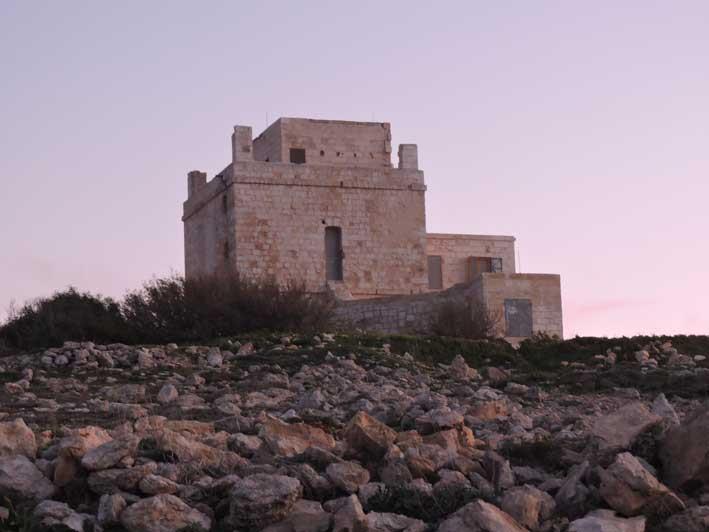
L-Aħrax Tower seen from its rear.
On the day of the award of the George Cross and according to the Diary of the 1st Btn, Mellieħa was bombarded three times, but mainly military targets got the attention of the enemy. At 2.20am enemy aircraft were reported to have dropped bombs on Għadira Camp but no damage or casualties were suffered. Thirty minutes later (2.50am) bombs were dropped in the sea, off Pillbox AB 1. Just an hour later (3.54am) bombs were reported to have fallen into the sea off Beach-Posts P1, P2 and P3. Throughout the day a considerable number of enemy fighters flew over Mellieħa on patrol. Four unexploded bombs were found in Għadira Camp. On 20 April 1942 at about 6pm German fighters machine-gunned Għajn Żnuber, where three soldiers from "D" Company were injured; one seriously and the other two slightly.
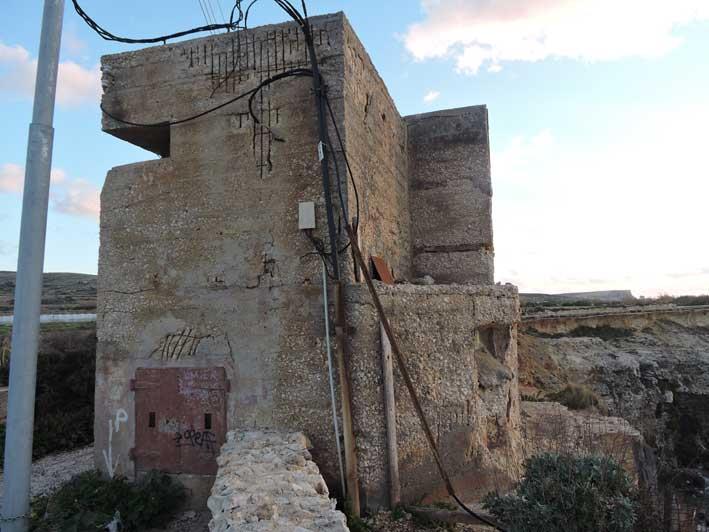
Pillbox AB 1.
The big day: Mellieħa and Għadira Camp bombarded heavily
The first alarm of 25 April 1942 came out in the first hours of the day when the Air Raid Warning (Air Raid No. 2187) was sounded at 1.49am, where it was reported that at 2.25am two bombs were dropped in the sea off L-Aħrax Tower. The Raiders Passed was sounded at 2.42am. Bombs were dropped and fell on Gudja. The second Air Raid Warning (Air Raid No. 2188) was sounded at 3.17am, but it might have been a false alarm or a nuisance raid, where no bombs were reported to have fallen in either part of Malta. The Raiders Passed was sounded at 4.23am.
However, during the third Air Raid Warning (Air Raid No. 2189), sounded at 6.40am, there were up to 85 Junkers Ju88s and 15 Junkers Ju87 Stukas which appeared over Mellieħa Bay and dropped High Explosive (H.E.) bombs of various calibres on Għadira Camp and west of Miżieb Valley and a large quantity of incendiary bombs on a wide area around Mellieħa, which were ineffective.
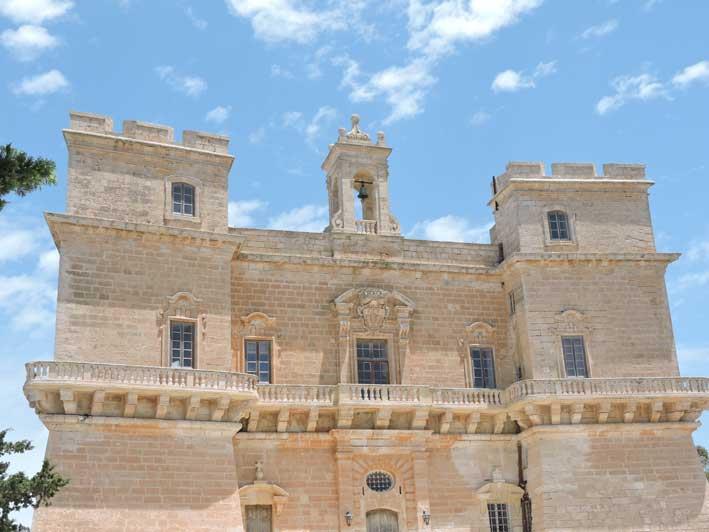
The façade of Selmun Palace.
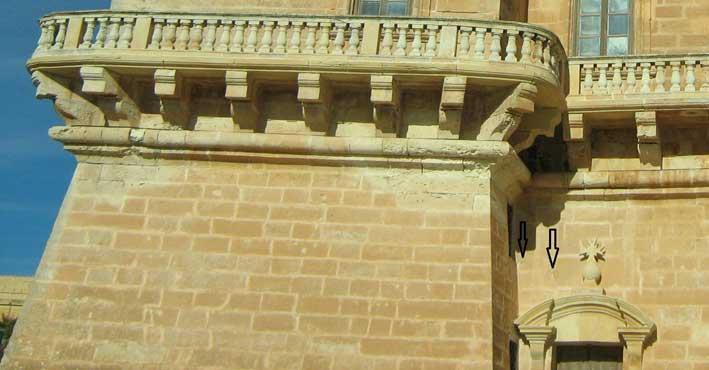
A photo of two splinters left on the façade of Selmun Palace after its attack.
The establishment of a Depot for KOMR recruits in Għadira Camp
In March 1942 Lieutenant Colonel H.D. Chaplin was ordered to establish a Depot for training KOMR recruits at Għadira Camp. It was to train four squads of 30 men each. The senior instructors and administrative staff were to be provided by British infantry battalions in Malta and the junior instructors by three battalions of the KOMR. On 29 March, the stores began to arrive at Għadira Camp and a party from the Queen's Own Royal West Kent Regiment erected the tents and marquees and opened up the camp. The instructors and staff arrived on 31 March and everything was in readiness to receive the recruits by 1 April. The Depot opened on 2 April 1942.
On 31 March, as the camp was being prepared, Lieut. Col. Chaplin and his comrades experienced their first strafing by Luftwaffe fighters: "Suddenly there was a roar of engines over the hill from Iċ-Ċumnija and the crack and thump of cannon shells exploding in the dust almost under our feet. We threw ourselves to the ground, upsetting tables and forms as we did so. Among the confusion I caught a glimpse of two German fighters disappearing out to sea over Mellieħa Bay."
Part 2 of this feature will be published on 2 May